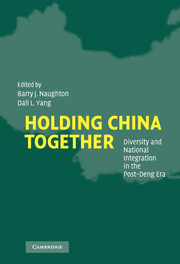Book contents
- Frontmatter
- Contents
- List of Figures and Tables
- List of Contributors
- Acknowledgments
- Holding China Together: Introduction
- PART ONE THE INSTITUTIONS FOR POLITICAL AND ECONOMIC CONTROL: ADAPTATION OF A HIERARCHICAL SYSTEM
- 1 Political Localism Versus Institutional Restraints: Elite Recruitment in the Jiang Era
- 2 The Institutionalization of Elite Management in China
- 3 The Cadre Evaluation System at the Grass Roots: The Paradox of Party Rule
- 4 Economic Transformation and State Rebuilding in China
- PART TWO CASE STUDIES OF POLICY IMPLEMENTATION
- Index
4 - Economic Transformation and State Rebuilding in China
Published online by Cambridge University Press: 08 December 2009
- Frontmatter
- Contents
- List of Figures and Tables
- List of Contributors
- Acknowledgments
- Holding China Together: Introduction
- PART ONE THE INSTITUTIONS FOR POLITICAL AND ECONOMIC CONTROL: ADAPTATION OF A HIERARCHICAL SYSTEM
- 1 Political Localism Versus Institutional Restraints: Elite Recruitment in the Jiang Era
- 2 The Institutionalization of Elite Management in China
- 3 The Cadre Evaluation System at the Grass Roots: The Paradox of Party Rule
- 4 Economic Transformation and State Rebuilding in China
- PART TWO CASE STUDIES OF POLICY IMPLEMENTATION
- Index
Summary
Historically, the development of modern market economies in different countries has pushed states to “develop rules about property rights, governance structures, rules of exchange, and conceptions of control in order to stabilize markets” (Fligstein, 2001, p. 36). In the United States, the historian Robert H. Wiebe famously noted, the march of nationalization,industrialization, mechanization, and urbanization exerted enormous strains on the ethos and institutions of small-town America and prompted a search for order (Wiebe, 1967). The state that was forged in the Civil War became inadequate to the push and pull of industrialism, and “a qualitatively different kind of state” was built in the late 19th and early 20th centuries during what is now known as the Progressive Era (Skowronek, 1982, p. 4). Civil service reforms were introduced to curb the corrupt localism and particularism of patronage politics; a managerial and regulatory state arose to tackle problems ranging from poor public health to monopolies. Echoes of the Progressive Era's political struggles and negotiations over the shape of this regulatory state continue to be heard in today's United States, often magnified in episodes such as the collapse of Enron and Worldcom.
As the postcommunist economies have dismantled their command economies, they have also faced the daunting challenges of refurbishing the state for the era of markets. In the 1980s and through the early 1990s, the Chinese reforms parceled out resources and power to local interests. Most studies of China suggested that the decentralization and the flattening out of the organization of the Chinese state contributed to the rapid growth of the Chinese economy (Oi, 1992; Qian and Xu, 1993).
- Type
- Chapter
- Information
- Holding China TogetherDiversity and National Integration in the Post-Deng Era, pp. 120 - 146Publisher: Cambridge University PressPrint publication year: 2004
- 9
- Cited by



